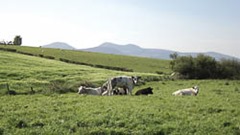Rural proofing
 Government departments and agencies are required to assess the impact of their policies on the countryside. Peter Cheney explains how the process works.
Government departments and agencies are required to assess the impact of their policies on the countryside. Peter Cheney explains how the process works.
Rural proofing is an exercise used within the Civil Service to make sure that the intended and unintended consequences of policies are considered when decisions are being made.
It was first introduced by then Agriculture and Rural Development Minister Bríd Rodgers in 2002 but the uptake was initially slow. A review in 2005 founded that the process was ineffective and cumbersome.
The Department of Agriculture and Rural Development (DARD) drew up an ‘enhanced rural proofing’ process which was approved by the Executive in July 2009. As a rule, settlements with a population of under 4,500 people are deemed rural but policy-makers are free to use alternative definitions, provided that they can set out their rationale.
The overall aim is to ensure that services are delivered in an “equitable manner” to rural areas – not an equal level of resources to urban areas but responding in a way that is proportional to their need. For example, an urban-style bus service would be inappropriate but buses should, as far as possible, reach the people who regularly depend on them.
A rural proofing exercise must start at the outset of a policy development or policy review process. If no direct or indirect impact is foreseen, this should be explained along with the reasons for that decision. However, if an impact is likely, the department or agency must gather evidence in order to explore the possible consequences. Early contact with rural stakeholders, who are likely to understand these issues, is “strongly recommended” and this should take place well before the public consultation phase.
While the previous approach relied on ticking boxes, the current approach asks officials to consider four broad aspects of policy:
1. design;
2. evidence;
3. consulting; and
4. monitoring and outcomes.
DARD suggests questions which help to identify the specific needs of rural areas. In terms of design, officials are asked to set out their policy objectives, any direct or indirect impacts (as explained above) and whether they have considered “pre-consultation” with stakeholders or what action is needed to mitigate against the impacts. Evidence must be presented to back up any predicted impact e.g. statistics, research or advice from stakeholders. Obviously, there may be areas of uncertainty where further evidence would be useful.
Consultation responses need to be read with a view to identifying comments about the needs of rural areas. Officials are asked to demonstrate how they have “targeted and fully engaged” with their rural stakeholders.
Lastly, a policy-maker should consider whether any specific indicators are needed to monitor how their policy is implemented in a rural area – and whether the outcomes will meet the objectives. They also need to explain how they will effectively evaluate the impact of their policies in a rural setting.
Some non-devolved policy areas (e.g. fuel taxation and postal services) also have a strong impact on rural areas.
The UK Department for Environment, Food and Rural Affairs’ Rural Communities Policy Unit advises policy-makers in Whitehall about the likelihood and possible scale of rural impacts, and suggests actions that might be taken to mitigate these. The Northern Ireland Office also has a responsibility to ensure that the province’s interests are taken into account at Westminster.





